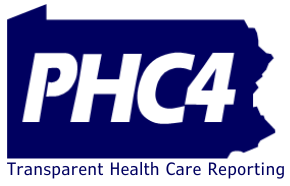Donald Bourne, MPH, MD-PhD student at the University of Pittsburgh School of Public Health used data from the Pennsylvania Health Care Cost Containment Council (PHC4) for his research dissertation study entitled, “Early Impacts of the Pennsylvania Rural Health Model on Potentially Avoidable Utilization.” He explained, “The Pennsylvania Rural Health Model (PARHM) is an effort to address some of the issues inherent in standard United States payment systems that can negatively impact rural hospitals and patients. PARHM is a first-of-its-kind alternative payment model aimed at transforming healthcare in rural Pennsylvania to deliver value-based care through hospital-based global budgets and care transformation plans. To improve the healthcare system, we must pay close attention to financial incentives and their intended and unintended consequences.”
Mr. Bourne used PHC4’s statewide inpatient discharge, ambulatory/outpatient procedure, and financial datasets in combination with its facility characteristics files to evaluate changes in the rate of potentially avoidable utilization. Hospital-specific variables such as hospital bed count (an indicator of hospital size), total margin (an indicator of a hospital’s financial health), and discharge rate (an indicator of case volume) were also analyzed using PHC4 data. Mr. Bourne explained, “We used a difference-in-differences analysis to isolate the effects of PARHM on hospitalizations that could have been avoided through access to high-quality outpatient care. This provided a good starting point for assessing changes in the quality of health services in the community.”
“The overall research for this study did not find a significant reduction in potentially avoidable utilization rates throughout the four years post-PARHM implementation, relative to changes in rural Pennsylvania communities whose hospitals did not join PARHM.” Mr. Bourne continued, “However, heterogeneous treatment effects were observed across cohorts that joined PARHM in different years.” The largest decrease in potentially avoidable utilization rates was observed in the critical access hospitals from the first cohort enrolled in the model. He explained that these were some of the smallest and most financially vulnerable hospitals to enter the model and that these results warrant further study. He further noted that he anticipates his future research will evaluate rural-urban disparities.
Mr. Bourne expressed, “PARHM is a payment model focused on the rural community. The model’s goals include improving financial health of rural hospitals, increasing access to high-quality care, improving population health outcomes, and reducing avoidable hospital expenditures. Our results show that PARHM moved the needle on reducing avoidable hospital expenditures for some groups of hospitals, but not all. It may be that a model as large in scope as this takes time for effects to mature, or the model may require changes in how it is structured.”
Mr. Bourne expressed, “One of the major benefits of using PHC4 data is that it is among the timeliest population-based healthcare data available.” He also mentioned that his experience working with PHC4 was excellent, and he and his team appreciated the knowledgeable and responsive staff at PHC4.
Return to the Case Studies page: VIEW ALL CASE STUDIES


